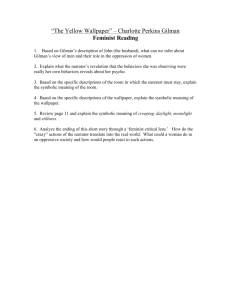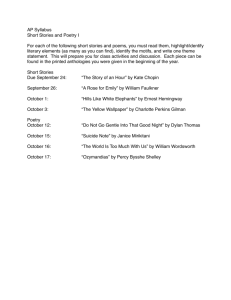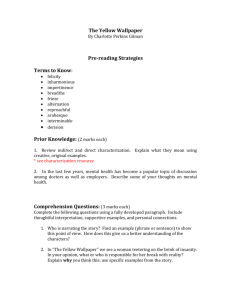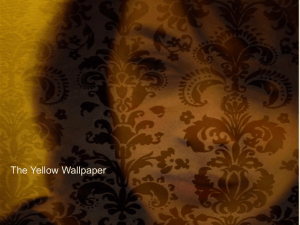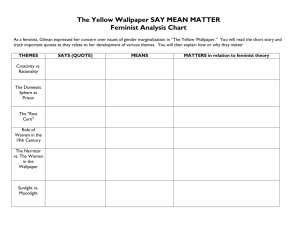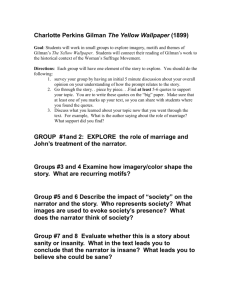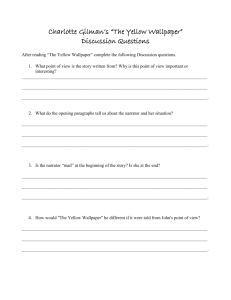The Yellow Wallpaper and Victorian Values
advertisement
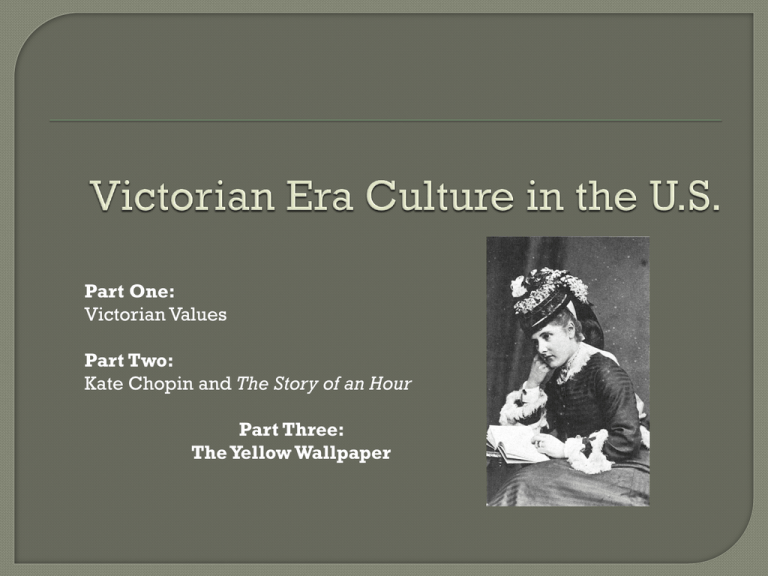
Part One: Victorian Values Part Two: Kate Chopin and The Story of an Hour Part Three: The Yellow Wallpaper Concepts to know: Colonialism Victorian Era Foreshadowing Situational Irony “Angel in the House” Gender Victoria’s Influence on American Culture • British Global Power and Colonization • The locomotive (train engine) • Telegraph • Effects of Industrialization • Cities as centers of industry/working poor • The United States still closely linked to British culture/values • Severe division of class Advances in technology World War I, World War II Industrialization Media and wide-spread knowledge distribution Angel in the House “In these paintings, wives support and soothe their husbands, or else, watch over and educate their children. [The wife is] an earthly Madonna of everyday life -- a saint of the hearth.” ~ Elizabeth Lee Rosetti’s Girlhood of Mary Virgin “The sorceress embraces her witch side, using her magic to the peril of her male victims.” Circe Offering the Cup to Ulysses John William Waterhouse, 1849-1917 Well, What Did You Think of My Poems?" by George Du Maurier. The Cornhill Magazine, Vol. 32 (1875), facing page 233 — Illustration for Thomas Hardy's The Hand of Ethelberta. Image scan, caption, and commentary by Philip V. Allingham. Lecture Three, Chopin and Feminist Approaches to Literature Born 1850; died 1904 in St. Louis Missouri Catholic upbringing; strong maternal figures Raised speaking French and English Husband was very wealthy Five sons and one daughter Wrote two novels and about a hundred short stories Most of her fiction is set in Louisiana Published by Vogue and the Atlantic Monthly Well-read and capable of socializing in various circles Husband died of malaria in 1882 Spent the Civil War in St. Louis, a city where residents supported both the Union and the Confederacy From 1867 to 1870 kept a "commonplace book" in which she recorded diary entries Writing for her was a therapy against depression Regionalism, Chopin’s “realism”: http://www.learner.org/amerpass/unit08/usingvideo.html The Story of an Hour Characters Setting Meaning Symbolism Tone Irony Louise Mallard Brently Mallard: husband of Louise Josephine: sister of Louise Richards: friend of Brently Mallard Susan Cahill called the story "one of feminism's sacred texts," and many readers have since concluded that Kate Chopin's sensitivity to what it sometimes feels like to be a woman is on prominent display in this work—as it is in The Awakening. Chopin's often-celebrated yearning for freedom is also on display here—as is her sense of ambiguity and her complex way of seeing life. It's typical of her to note that it is both "men and women" who "believe they have a right to impose a private will upon a fellow-creature." Wrote The Yellow Wallpaper after she had a severe case of postpartum depression Essentially a response to her doctor, who tried to cure through a “rest cure” Gilman was a women’s rights activist in the late 1800’s Used her fiction to raise feminist issues and to bring about a change in their circumstances In The Yellow Wallpaper she tells a story of a woman entrapped within the confines of her marriage and her expected roles as a woman and it is this perhaps that causes the woman’s madness. “If a physician of high standing, and one’s own husband assures friends and relative that there is really nothing the matter with one but temporary nervousness depression – a slight hysterical tendency – what is one to do?... So I take phosphates or phosphites – whichever it is, and tonics, and journeys, and air, and exercise, and am absolutely forbidden to “work” until I am well again. Personally I disagree with their ideas” After Gilman had written “The Yellow Wallpaper” she decided to write an explanation of her purpose or so-what behind the story. She says that she based it on her own personal experiences through this disease and “it was not intended to drive people crazy, but to save people from being driven crazy, and it worked.” (Gilman, “Why I wrote Yellow Wallpaper”) In The Yellow Wallpaper, the author uses a number of literary devices to illustrate the oppression of women during the Victorian era. To achieve her goal of expressing feminist sentiment in The Yellow Wallpaper, Gilman creates a Narrator who is at once expressive about her feelings but is also prone to devaluing her own assessments. The woman in the story is trapped, having to act out the role expected of her She does not feel equipped for a life of being a perpetual wife and mother Her stillness and stagnation cause her mind to weaken and lose the insight it once had Is this an instance of an unreliable narrator or is it a ghost story? John, the narrator’s husband, treats her like a child Bars on the windows and the gate on the stairs represent the lack of freedom she has within her life and marriage. The marital bed is nailed down to the floor The woman trapped within the wallpaper represents the Victorian women trapped within their feminine roles unable to break down the barriers of language to be able to freely express themselves. However at the end of the story the woman is liberated so there is hope that through the use of language women could one day be free of their constraints. Gilman was later diagnosed with incurable breast cancer and she killed herself with an overdose of chloroform rather then letting others be in charge of her life. You may want to watch this on You Tube: The Yellow Wallpaper PBS Masterpiece Theater 1989 ... - YouTube
